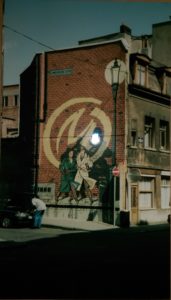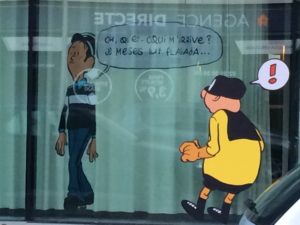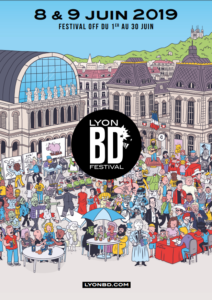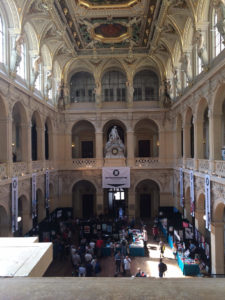Really Only One Story Today
And we’ll get to that in a moment. In the meantime, I trust you’ve seen that MICE has postponed its exhibitor registration, to be re-evaluated in June, that BOOM! Studios has made Hope Larson’s first Goldie Vance graphic novel free to read, and Diamond (a blight on comics in general) has announced it’s not going to be doing anything for a while. Having a monopoly on distribution in the comics direct market is an awesome idea, you guys.
That one story today, thought? We lost a giant in the world of comics. Albert Uderzo, illustrator and co-creator (with René Goscinny¹) of Astérix, died at the age of 92. It was unrelated to the current global crisis, not that there’s a good time or way to die, but reports are that he died in his sleep of a heart attack after feeling tired for a couple weeks. In the grand scheme of things, I’d be happy to have that one. Fleen Senior French Correspondent Pierre Lebeapin is working on a suitable remembrance, which we will have in the next day or two.
But while Uderzo’s death was unexpected, the ongoing effects of the novel coronavirus are not, and FSFCPL has some words from our European desk about how the [web]comics scene over there is reacting.
In these times of lockdown it seems that publishers left and right are dropping digital comics to read for free, but in that they are merely following in the footsteps of webcartoonists, who have already moved on from that to the next thing: creating works where you can contribute. Yes, you.
- Many creators have posted the inked layer for comics plates or illustrations, for everyone to color; not particularly unexpected, but this is a classic exercise and is worth a mention. We can report that Riad Sattouf, Pénélope Bagieu, Marie Boiseau, Norbert, Thorn (twice), Fabien Lambert, Marion Barraud, Timothy Hannem (where you can also look for the hidden 20 cats), Alice Des where you can also look for some objects — instructions only in French, sorry), Marion Poinsot, Julie Gore et Eric Wantiez, Aurélien Fernandez, and Sandrine Deloffre are doing so (careful, some of these links may expire shortly).
- Let us stay with Deloffre a bit longer: those are taken from her book called Les Cartes de Désavoeux, which I will roughly translate as Ill-Wishing Cards. Kind of a mirror universe Hallmark or American Greetings, though omitting any IP, thankfully. And she has posted the instructions on how you can do your own, which I will translate as best as I can manage:
- Trace a round shape with a round object (e.g. glass, soccer ball, the cap of a Pringles can, swimming pool, …)
- Define a goal: to whom? Why? How much do you care about this person? Do you have means of defense in the event of an aggression?
- Settle on a pattern an apply it on the outer surface of the previously traced round shape (e.g. flowers, stars, golden statues representing Vercingétorix, penis wearing a sombrero …)
- Settle on a message combining subtlety and realism and inscribe it upon the center of the circle while applying yourself. Don’t hesitate to overdo it.
- Gift the ill-wishing card to someone who deserves it. (e.g. nobody, because nobody deserves this card, because everyone walks in isolation in this long putrid and foul-smelling sewer we call life, we walk alone and we will die alone, eaten up by our cats, except if we’re allergic).
- On the initiative of Bagieu, an idea by Oscar Barda, critical contributions by Deloffre, and a template by Hannem, the Coronamaison (translated hastag #coronahome was suggested by Moemai, should you need one) was born. The prompt: you draw the house floor along with its decoration/companions/pets/food/windows where you would want to be locked down, ideally.
It kind of exploded, with #coronamaison having now thousands of hits on Instagram, though I think they are best seen on Twitter, where they remain (mostly) uncropped; alternately, Hammen is retweeting pretty much all of them. Of particular notice to your correspondent are Obion’s), Boulet’s, Luppi’s, Moemai’s, Maitre et Talons’, Jakuboy’s, Margaux Saltel’s, and of course Bagieu’s, Deloffre’s, Hannem’s, and Barda’s.
- Meanwhile, Maliki offers a dialogue-free version of her latest strip, for you to represent what your timeline is looking like in these days of lockdown (and yes, Animal Crossing vs Doom has already been done).
- Every day, Lewis Trondheim proposes a challenge where he posts the first three panels of a strip he just created, to see if you can guess the punchline in the fourth panel; the challenge being that your response must be in the form of a drawn panel, even badly. Be sure to follow him closely, as some have managed to find the solution in 10 mere minutes.
- Meanwhile, Boulet proposes a game he co-created with his goddaughter Maya, where the game is mostly a pretext to draw hybrids; many creations can be seen in response to his tweet. Note that they need not be as elaborate as his barbarian Slowbro.
- And Erwann Surcouf, on his side, proposes the randomized comic story generator he created for Spirou magazine a while back; no English version of the instructions appears to be available, unfortunately.
- We complete by a digression though French law Twitter, where Solinette proposes we liven up the form where we French must attest for ourselves the business we have for going outside our home (e.g. buy basic necessity goods or bring out the pet), and that many of us (your correspondent included) have to fully copy by hand, for lack of a printer at home. Every day: they’re dated. Yes, it’s France, of course we have to have bureaucracy even between one and oneself.
- Still in French law Twitter, Maitre et Talons encourages children to draw in support of healthcare professionals to thank them like she or Deloffre do. She also wants you to send her photos so she can draw herself in them.
And remember: wash your hands, sneeze and cough in your elbow pit, practice social distancing, and for the Flying Spaghetti Monster’s sake, stay at home. You have more than enough to keep yourself busy now.
Fleen, as always, thanks M Lebeapin for his reportage.
Spam of the day:
It looks like you’ve misspelled the word “remeniscences” on your website. I thought you would like to know :)
Nobody tell her.
_______________
¹ Who died more than 40 years ago. For that matter, Uderzo retired nearly a decade ago, turning over writing and art to Jean-Yves Ferri and Didier Conrad, respectively.







